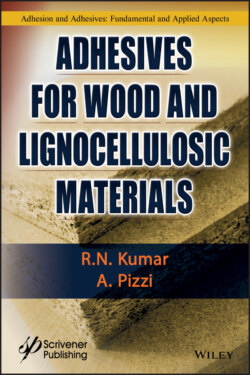Читать книгу Adhesives for Wood and Lignocellulosic Materials - R. N. Kumar - Страница 24
1.4.3.1 Lignin Isolation
ОглавлениеIsolation of lignin in an unchanged form (native lignin) is rendered difficult due to its complex structure and its location within the cell wall. Hence, determination of the exact chemical structure of lignin is therefore difficult [11]. All methods of isolation have the disadvantage of either fundamentally changing the native structure of lignin or releasing only a part of it in a relatively unchanged condition.
There are two methods by which lignin can be isolated from extractive free wood [19]:
1 As an insoluble residue after hydrolytic removal of the polysaccharides.
2 Alternatively, lignin can be hydrolyzed from wood or converted into soluble derivative.
According to method (1) the polysaccharides can be removed in the following procedures:
1 Klason lignin: Klason lignin is obtained after removing the polysaccharides from extractives-free wood by hydrolysis with 72% sulfuric acid.
2 Cellulolytic enzymes may be used to dissolve polysaccharides from finely divided wood meal leaving behind lignin as residue. This lignin is called cellulolytic enzyme lignin (CEL). This method is tedious but the CEL retains its original structure essentially unchanged.
Bjőrkman lignin, also called milled wood lignin (MWL), has been widely used for structural studies. Wood meal is ground in a ball mill either without any solvent or with a solvent such as toluene, which is a non-swelling solvent. The lignin can then be extracted by using a mixture of dioxane, water, and HCl (dioxane lignin). Lower temperature extraction minimizes structural changes of lignin.
A number of researchers have tried the dioxane method in lower temperature (and consequently lower yields) to minimize structural changes in extracted lignins [4].
For the extraction of lignins, a modified dioxane method and ionic liquid and comparative molecular weight (MW) and structural studies by chromatography and 13C NMR spectroscopy techniques were used [20].
In recent years, ionic liquids have been used to dissolve carbohydrates, and lignin residue is hoped to be relatively unchanged [21].
The second method involves the formation of soluble lignin derivatives, namely, lignosulfonate.
